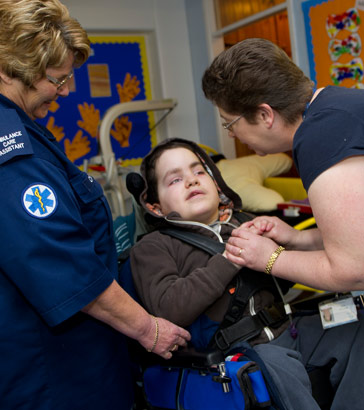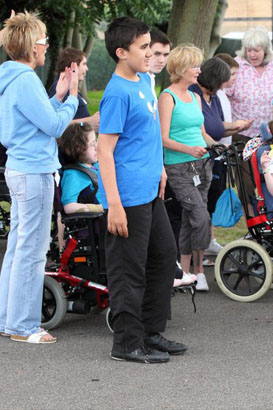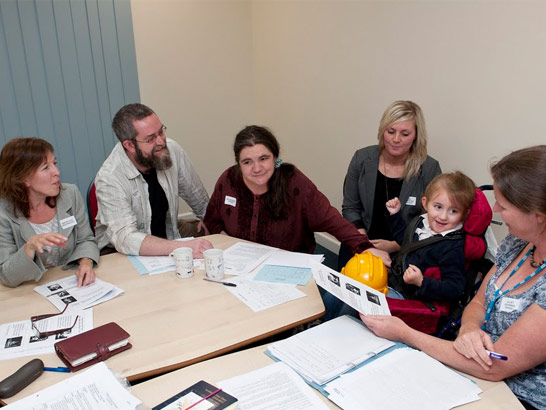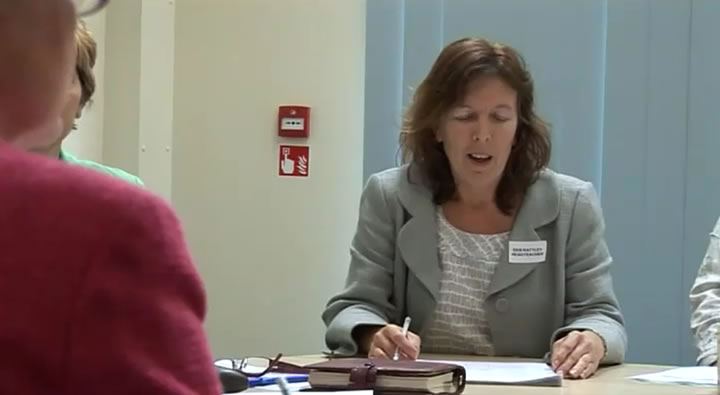
For a child aged two or more or a young person, 'special educational provision' is defined in the Children and Families Act 2014 as:
- '…educational or training provision that is additional to, or different from, that made generally for others of the same age in the following settings in England: mainstream schools, mainstream post-16 institutions, maintained nursery schools and other places that provide relevant early years education. In relation to a child under that age, special educational provision means educational provision of any kind.'
From 1 September 2014, the 0-25 SEND Code of Practice (2014, 2015) has played a vital role in the special educational needs/disabilty framework reform. Significantly, it was jointly published by the Department for Education and the Department of Health, indicating the inter-agency nature of the guidance. (The previous Special Educational Needs Code of Practice (2001) was published solely by the Department of Education and Skills.)
This Code of Practice relates to children and young people with special educational needs (SEN) and/or disabilities. It applies to England and gives statutory guidance on duties, policies and procedures relating to Part 3 of the Children and Families Act 2014 and its associated regulations.
All the organisations who must take account of the 0-25 SEND Code of Practice are listed in the 'Introduction'. This includes National Health Service bodies. The Code of Practice sets out the processes and procedures that all these organisations must or should follow to meet the needs of children.
Find out more from the Department for Education guidance here.

Significant areas within the Special Educational Needs and Disability Code of Practice (2015), include:
- Application to all education/training phases between ages 0-25;
- Coordinated assessment and Education, Health and Care (ECH) Plans;
- Joint commissioning;
- Involvement of children/young people and their parents;
- The 'local offer';
- Personal budgets;
- Preparing for adulthood and post-16 provision;
- Organisational change and workforce development.
(Leach, 2014)
Children/young people with special educational needs/disabilities need different levels of 'SEN support' according to their needs. Appropriate provision, based upon individual needs, is achieved through a 'graduated approach' in which evidence-based adaptations and interventions build on universal high-quality teaching approaches. The initial decision to intervene, and the ongoing monitoring of intervention effectiveness and adjustment is carried out using an 'assess, plan, do, review' approach.
The school's notional special educational needs budget covers the cost of interventions up to 'a nationally prescribed threshold per pupil per year' (Department for Education, 2014); once the cost of interventions exceed this, educational settings can apply to the responsible local authority for top-up funding. This may (although not necessarily unless the young person is over 19 years) lead to an Education, Health and Care (EHC) Needs Assessment, which can be generated by the local authority themselves or in response to a request from the parents, young person or educational setting.
The 'graduated approach' is explained in the 0-25 years SEND Code of Practice (2015) sections 5.38-5.46).

With reference to your school's Special Educational Needs and Disability Policy and conversations with your school's SENCO, list the stages of enhancing provision to address a child's/young person's emerging special educational needs starting with 'Quality first teaching' and ending with a referral for an 'Education, Health and Care (EHC) Needs Assessment'.
Research and write a short description to explain each term to a teacher new to special education.
Think in depth about how one of the stages applies to a child/young person you work with. In what ways are the aims/objectives associated with the stage being (or not being) addressed?
When a child/young person is referred for an Education, Health and Care (EHC) Needs Assessment, the local authoritys decision to undertake one should rest on evidence that the educational setting has taken 'relevant and purposeful action to identify, assess and meet the special educational needs of the child or young person' (DfE, 2014).
Where, despite appropriate assessment and provision, the child or young person is not progressing sufficiently well, the local authority should consider whether an Education, Health and Care (EHC) Plan is required in the context of:
- Any significant changes in the child's/young person's circumstances (eg change of setting);
- How long the special educational needs have been apparent;
- The likely progression of a child's/young person's condition;
- Whether the provision can reasonably be resourced by the educational setting or if the local authority must prepare an EHC Plan.
'Where, in the light of an EHC assessment, it is necessary for special educational
provision to be made in accordance with an EHC plan, the local authority must
prepare a plan.'
(DfE, 2014)
Click here to view the 20-week statutory EHC Needs Assessment time frame.
When carrying out an an Education, Health and Care (EHC) Needs Assessment of a child/young person, the authority must seek clear, accessible and specific advice from:
- The child's parent(s) or the young person;
- The manager, headteacher or principal of the educational setting attended by the child or young person (or an alternative suitable person);
- Health care professionals;
- An educational psychologist;
- Social care services;
- From Year 9 onwards, advice and information related to the child's/young person's preparation for adulthood and independent living;
- Any other person requested by the child's parent or young person, where the local authority considers this reasonable;
- Any other relevant specialist advice and information (eg reports from specialist teachers, a designated teacher and/or a virtual head; Early Help assessments; youth offending team; etc) that the local authority considers appropriate for a satisfactory assessment.
The local authority must give to those providing advice copies of any representations
made by the child's parent or the young person, and any evidence submitted by or at
the request of the child's parent or the young person.
(DfE, 2014)
As a result of a statutory assessment, a local authority will take a decision on whether or not to issue an Education, Health and Care (EHC) Plan. In either event, it must notify the child's parent or the young person and give the reasons for its decision within the statutory timescale.
'The purpose of an EHC plan is to make special educational provision to meet the
special educational needs of the child or young person, to secure the best possible
outcomes for them across education, health and social care and, as they get older,
prepare them for adulthood.'
(DfE, 2014)
Before the implementation of the new special educational needs framework (1 September 2014), local authorities could have issued a Statement of Special Educational Needs (primary and secondary settings) or a Learning Disability Assessment (further education settings).
During the transitional period (September 2014 to March 2018) local authorities must gradually transfer special educational provision made under the Education Act 1996 and the Learning and Skills Act 2000 to the new framework under the Children and Families Act 2014.
See the Department for Education statutory guidance here.

An EHC Plan describes the educational, health and social care needs of a child/young person under the age of 25 years. It identifies long term outcomes agreed with the young person/their parents and the necessary provision for the child/young person to work towards achieving them. Provided the young person remains in education or training, EHC Plans can be maintained up to the age of 25.
The EHC Plan comes into force as soon as it is finalised by the local authority. From that time, the local authority must ensure that any provision specified in the plan is made available. The school's governors must do their best to make sure the child gets the special educational help to achieve the outcomes set out in the EHC Plan.
The EHC Plan is legally binding and enforceable, and can only be changed by agreement by parties concerned through a formal review, or by appeal to a Special Educational Needs and Disability Tribunal.
The format of an Education, Health and Care (EHC) Plan is not stipulated in law
and can be agreed locally, although it must include the following separately labelled
sections summarised below:
A: Child's/young person's/parents' views, interests and aspirations;
B: Child's/young person's special educational needs;
C: Health needs related to SEN;
D: Social care needs related to SEN/disability;
E: The outcomes sought for the child/young person, including outcomes for adult life, and short-term target-setting;
F: The special educational provision required;
G: Any health provision reasonably required;
H1: Any social care provision under the Chronically Sick and Disabled Persons Act 1970;
H2: Any other social care provision
reasonably required;
I: The name (if required) and type of educational setting proposed;
J: Details of personal budget/direct payments;
K: List of EHC Needs Assessment advice and information (to be appended in full).
More detailed information and guidance on section contents is given in the 0-25
SEND Code of Practice (2015) (sections 9.62-9.76).
An example of an EHC Plan can be seen here.
Note how these sections differ from those in the Statement of Special Educational Needs issued under the 2001 special educational needs framework. An example of a fictional statement can be seen here.

Local authorities must check each child’s progress and make sure that the statutory assessment document (ie Education, Health and Care (EHC) Plan or Statement of Special Educational Needs) continues to meet their special educational needs. They must review the document under the relevant 2014 or 2001 legislation/regulations/guidance at least once a year, but they can do it more often if required.
The procedures for organising annual reviews are set out for:
EHC Plan reviews
The EHC Plan review process is set out by law in the 0-25 SEND Code of Practice (2015) and Special Educational Needs and Disability Regulations (2014). Within a statutory time frame:
- The LA must consult about the plan with parents,
the young person and the school about the
EHC Plan. - Contributions from parents, the young people and
involved professionals must be gathered
then circulated. - Following the meeting, a meeting report (including recommendations on EHC Plan amendments) must be circulated for discussion to everyone who contributed (in person, by proxy or in writing).
- The LA reviews the EHC Plan after the meeting, and
must notify the parent/young person whether they intend to maintain it unchanged,
amend it or cease it. (Any decision concerning the educational contents of the plan
can be appealed through mediation and/or the Tier 1
(special educational needs/disability) Tribunal.)
Return
Education, Health and Care Plans
Reviews should, in relation to the child's/young person's progress towards outcomes and their access to teaching and learning:
- Gather and assess information to increase the effectiveness of 'SEN support';
- Review the effectiveness of their existing special educational needs provision;
- Review the effectiveness of health and social care provision;
- Consider, in the light of present circumstances, the continuing appropriateness of, and possible changes to, the Education, Health and Care (EHC) Plan (eg outcomes, level of provision, educational establishment, plan continuation, etc);
- Set new interim targets for the coming year and, where appropriate, agree new outcomes;
- Review any interim targets set by the early years provider, school or college or other education provider.

The following video clips show contributions to an Annual Review of a Statement of Special Educational Needs (SSEN) from children, parents and professionals. (SSENs reviews may take place under the Education Act 1996 until the child's/young person’s educational provision is transferred to the new special educational needs framework before April 2018; those with Learning Disability Assessments must have transferred before September 2016.)
The principles of contributions are similar to those in an Annual Review of an EHC Plan, but what additional discussions might you expect to take place in the context of what is being said in the following clips? Note down both the shared principles and any additional EHC Plan discussion points.
Who attends a review?
Watch these two video clips in which the headteacher opens meetings to review the progress of two children, Marley and Sophia. Consider the range of people involved, their respective roles and the variety of expertise they bring.
-
 Review meeting 1 (Sophia)8:11Presentation from class teacher at her special school placement.
Review meeting 1 (Sophia)8:11Presentation from class teacher at her special school placement. -
 Review meeting 1 (Marley)0:30Introduction
Review meeting 1 (Marley)0:30Introduction
The parties who contribute to the review also contributed to the child's/young person’s statutory assessment. If key professionals are unable to attend review meetings, they send in reports. Watch this video clip in which Marley’s parents comment on reports from the visual impairment service and the music therapist.
Task: Pupil's voice (1)
-
 Sophia joins her review meeting.2:40
Sophia joins her review meeting.2:40 -
 Sophia's teacher describes helping Sophia to participate in her review.3:51
Sophia's teacher describes helping Sophia to participate in her review.3:51
review meeting.

Both of the reviews that you have seen led to agreed actions. What would happen
if they did not?
In the most serious cases, the parents may appeal to a tribunal. These are discussed
in more detail in the next section.

Legislation and guidance
- Education Act 1996
- Learning and Skills Act 2000
- Special Educational Needs Code of Practice 2001
- The Education (Special Educational Needs) (England) (Consolidation) Regulations 2001
- Children and Families Act 2014
- The Special Educational Needs and Disability Regulations 2014
- SEND: Managing Changes to Legislation from September 2014
- Special Educational Needs and Disability Code of Practice: 0-25 years (DfE, 2015)
Other publications
- Leach, J. (2014) 'The Children and Families Act 2014: an overview of the SEND reforms in relation to Short Breaks' (presentation). London: Enfield Council.

